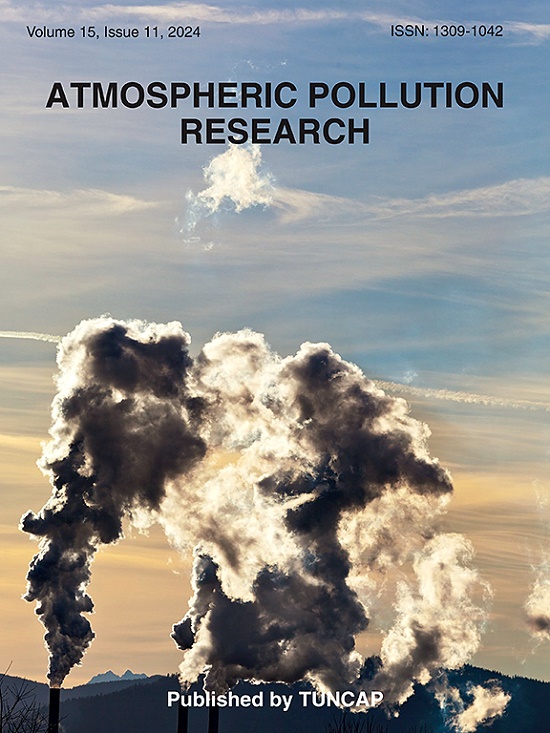73个主要城市PM2.5浓度评价及其与卫星气溶胶光学深度的关系:全球环境空气污染分析
IF 3.5
3区 环境科学与生态学
Q2 ENVIRONMENTAL SCIENCES
引用次数: 0
摘要
空气污染是现代社会一个显著的环境健康风险因素,影响着99%的人口。在本研究中,我们基于2019年1月至2024年3月全球76个AirNow站点的PM2.5地表测量数据,研究了全球细颗粒物(PM2.5)城市足迹,并研究了其与基于卫星的气溶胶光学深度(AOD)的关系。76个监测站全年空气质量指标均超过世界卫生组织(WHO)年平均指标(5 μg/m3), 29个监测站超过WHO年平均中期指标1 (35 μg/m3),无一例外。全球平均PM2.5浓度图显示南亚是一个热点地区,这些浓度维持在相当高的水平。世界银行国家收入水平分组的分解揭示了收入不平等,中低收入国家(中位数为42.1 μg/m3)和中高收入国家(中位数为22.5 μg/m3)之间存在差距。AirNow和中分辨率成像光谱仪(MODIS)的PM2.5-AOD对在站点间的相关性显示出较大的差异,R值在- 0.60 ~ 0.79之间。在老挝万象的一个案例研究中,地球静止环境监测光谱仪(GEMS)和MODIS AOD卫星产品表明,由于有一天内获取的能力,可以获得相当多的GEMS观测数据。仔细观察GEMS的AOD-PM2.5每小时对,可以看到一个清晰的日模式。这一大规模实验的结果展示了协同使用全球AirNow地面监测系统和卫星产品的稳健性和适用性。本文章由计算机程序翻译,如有差异,请以英文原文为准。
Evaluation of urban PM2.5 concentrations over 73 major cities and their association with satellite Aerosol Optical Depth: A global analysis of ambient air pollution
Air pollution is a notable environmental health risk factor in modern society, affecting 99 % of the population. In the current study, we investigate the global fine Particulate Matter (PM2.5) urban footprint based on PM2.5 surface measurements from 76 AirNow stations worldwide from January 2019 until March 2024 and investigate the association with satellite-based Aerosol Optical Depth (AOD). All 76 stations in all years, with no exception, exceed the World Health Organization (WHO) annual average air quality guideline level (i.e., 5 μg/m3), and 29 stations exceed the WHO annual average interim target 1 (i.e., 35 μg/m3). The global map of the mean PM2.5 concentrations indicate a hotspot in South Asia where these concentrations sustain considerably high levels. Disaggregation by World Bank country income level groups reveals income inequality with a gap between the lower-middle (median 42.1 μg/m3) and the upper-middle (22.5 μg/m3) income countries. Site-specific correlations on PM2.5-AOD pairs from AirNow and the Moderate Resolution Imaging Spectroradiometer (MODIS), respectively, for statistically significant observations show a large variation between stations, with R ranging between −0.60 and 0.79. In a case study over Vientiane, Laos, the Geostationary Environment Monitoring Spectrometer (GEMS) and MODIS AOD satellite products indicate a considerably higher number of GEMS observations available due to intra-day acquisition capability. A closer look at the GEMS AOD-PM2.5 hourly pairs show a clear diurnal pattern. The results of this large-scale experiment showcase the robustness and applicability of the synergistic use of the global AirNow surface monitoring system and satellite products.
求助全文
通过发布文献求助,成功后即可免费获取论文全文。
去求助
来源期刊

Atmospheric Pollution Research
ENVIRONMENTAL SCIENCES-
CiteScore
8.30
自引率
6.70%
发文量
256
审稿时长
36 days
期刊介绍:
Atmospheric Pollution Research (APR) is an international journal designed for the publication of articles on air pollution. Papers should present novel experimental results, theory and modeling of air pollution on local, regional, or global scales. Areas covered are research on inorganic, organic, and persistent organic air pollutants, air quality monitoring, air quality management, atmospheric dispersion and transport, air-surface (soil, water, and vegetation) exchange of pollutants, dry and wet deposition, indoor air quality, exposure assessment, health effects, satellite measurements, natural emissions, atmospheric chemistry, greenhouse gases, and effects on climate change.
 求助内容:
求助内容: 应助结果提醒方式:
应助结果提醒方式:


